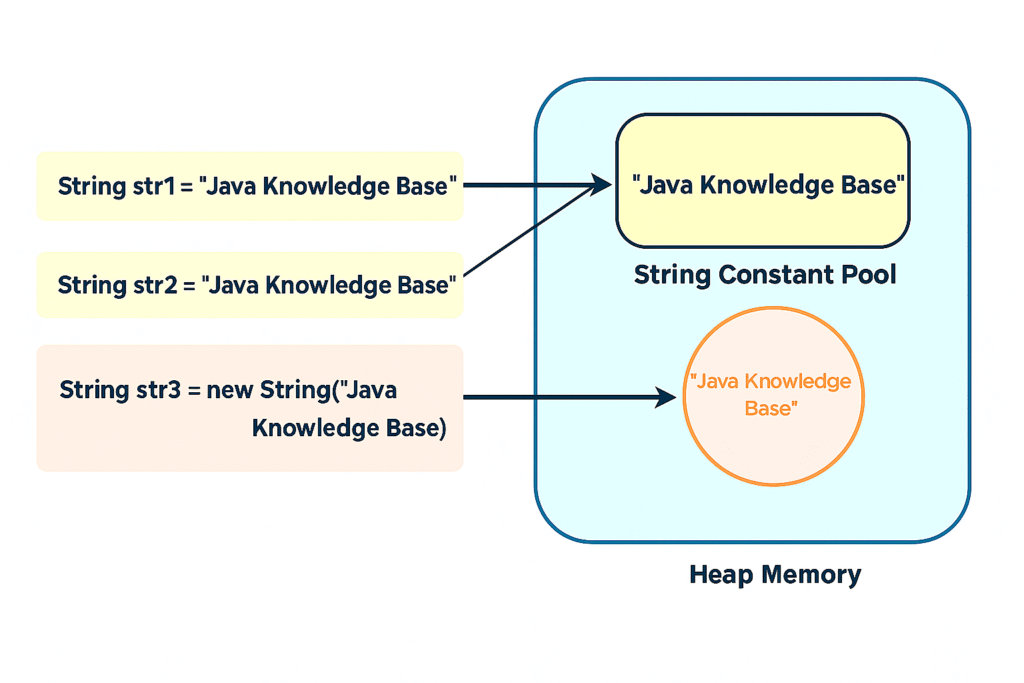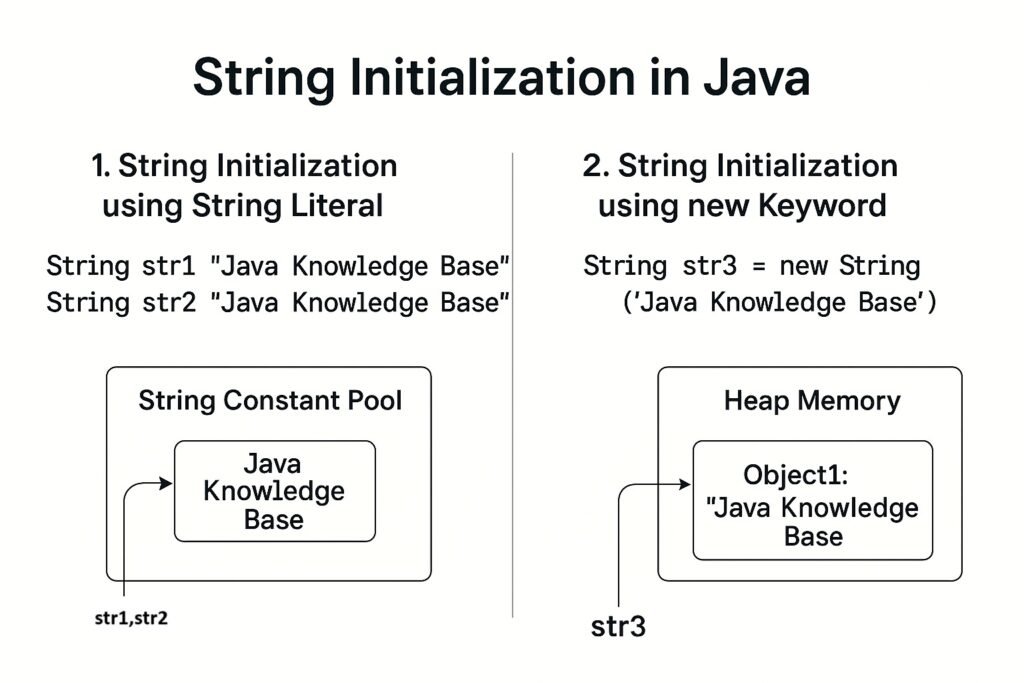Introduction to OOPs Concepts in Java
Introduction to OOPs Concepts in Java
Object-Oriented Programming (OOP) is a programming paradigm that uses objects and classes to model real-world entities. Java is a purely object-oriented language (except for primitive types), making it ideal for understanding OOPs concepts.
The main principles of OOPs in Java are:
- Class and Object
- Encapsulation
- Inheritance
- Polymorphism
- Abstraction
We’ll discuss each principle in detail with examples.
1. Class and Object
Class is a blueprint for creating objects. It defines properties (fields) and behaviors (methods) of an object.
Object is an instance of a class. Each object has its own state and behavior.
Example:
// Class definition
class Car {
String color;
String model;
void displayDetails() {
System.out.println("Car model: " + model + ", Color: " + color);
}
}
// Main class
public class Main {
public static void main(String[] args) {
// Object creation
Car car1 = new Car();
car1.color = "Red";
car1.model = "Toyota";
Car car2 = new Car();
car2.color = "Blue";
car2.model = "Honda";
car1.displayDetails();
car2.displayDetails();
}
}
Explanation:
Caris a class.car1andcar2are objects of theCarclass.- Each object has its own values for
colorandmodel.
2. Encapsulation
Encapsulation is the wrapping of data (variables) and code (methods) together as a single unit. It also restricts direct access to some of the object’s components, making the class more secure.
- Access Modifiers like
private,public, andprotectedcontrol access. - Getters and Setters are used to access private variables.
Example:
class Person {
private String name;
private int age;
// Getter for name
public String getName() {
return name;
}
// Setter for name
public void setName(String name) {
this.name = name;
}
public int getAge() {
return age;
}
public void setAge(int age) {
if(age > 0) {
this.age = age;
} else {
System.out.println("Age must be positive");
}
}
}
public class Main {
public static void main(String[] args) {
Person person = new Person();
person.setName("Alice");
person.setAge(25);
System.out.println("Name: " + person.getName());
System.out.println("Age: " + person.getAge());
}
}
Explanation:
- The
Personclass uses private fields to restrict direct access. - Getters and setters allow controlled access to these fields.
3. Inheritance
Inheritance allows a class to inherit properties and methods from another class, promoting code reusability.
- Super Class (Parent class) – The class whose features are inherited.
- Sub Class (Child class) – The class that inherits features.
Example:
// Parent class
class Animal {
void eat() {
System.out.println("This animal eats food.");
}
}
// Child class
class Dog extends Animal {
void bark() {
System.out.println("Dog barks");
}
}
public class Main {
public static void main(String[] args) {
Dog dog = new Dog();
dog.eat(); // inherited from Animal
dog.bark(); // own method
}
}
Explanation:
Doginherits theeat()method fromAnimal.- This demonstrates code reuse.
4. Polymorphism
Polymorphism means “many forms.” In Java, it allows objects to take multiple forms. There are two types:
- Compile-time polymorphism (Method Overloading)
- Runtime polymorphism (Method Overriding)
Example 1: Method Overloading
class Calculator {
int add(int a, int b) {
return a + b;
}
double add(double a, double b) {
return a + b;
}
}
public class Main {
public static void main(String[] args) {
Calculator calc = new Calculator();
System.out.println(calc.add(5, 10)); // Calls int method
System.out.println(calc.add(5.5, 10.5)); // Calls double method
}
}
Example 2: Method Overriding
class Animal {
void sound() {
System.out.println("Animal makes sound");
}
}
class Cat extends Animal {
@Override
void sound() {
System.out.println("Cat meows");
}
}
public class Main {
public static void main(String[] args) {
Animal myCat = new Cat();
myCat.sound(); // Runtime polymorphism
}
}
Explanation:
- Overloading – Same method name, different parameters.
- Overriding – Child class provides its own implementation of a parent method.
5. Abstraction
Abstraction is the concept of hiding implementation details and showing only functionality.
- Achieved using abstract classes or interfaces.
Example 1: Abstract Class
abstract class Shape {
abstract void area(); // abstract method
}
class Circle extends Shape {
double radius;
Circle(double radius) {
this.radius = radius;
}
void area() {
System.out.println("Circle area: " + (3.14 * radius * radius));
}
}
public class Main {
public static void main(String[] args) {
Shape shape = new Circle(5);
shape.area();
}
}
Example 2: Interface
interface Vehicle {
void run();
}
class Bike implements Vehicle {
public void run() {
System.out.println("Bike is running");
}
}
public class Main {
public static void main(String[] args) {
Vehicle bike = new Bike();
bike.run();
}
}
Explanation:
- Abstract classes and interfaces allow you to define “what” a class should do, without specifying “how.”
Other Important OOP Concepts in Java
- Constructors – Special methods to initialize objects.
- This Keyword – Refers to the current object instance.
- Super Keyword – Refers to the parent class object.
- Final Keyword – Used to declare constants, prevent inheritance or method overriding.
- Static Keyword – For class-level variables and methods.
OOPs Concepts in Real World Example
Imagine a Banking System:
- Class:
BankAccount - Object:
account1for John,account2for Alice - Encapsulation:
balanceis private; access via getters/setters - Inheritance:
SavingsAccountextendsBankAccount - Polymorphism: Different types of accounts have different
calculateInterest()methods - Abstraction: Interface
Transactiondefinesdeposit()andwithdraw()methods
Conclusion
OOPs concepts in Java make programs:
- Modular – Code is divided into classes/objects
- Reusable – Through inheritance and polymorphism
- Secure – Through encapsulation
- Easy to maintain – Abstraction hides complex logic
Understanding these principles is crucial to mastering Java and building scalable applications.

